In the mountains above the southwestern Chinese town of Dali, dozens of new wind turbines dot the landscape — a symbol of the country’s sky-high ambitions for clean, green energy.
At an altitude of 3,000m, Dali Zhemoshan is the highest wind farm in China, where renewable energy has become a priority for a government keen to reduce its carbon emissions and which has taken full advantage of the global trade in carbon credits.
“Wind resources in Yunnan province are not the best in the country,” says Zhai Cheng, a project manager at the farm for the Chinese group Sinohydro.
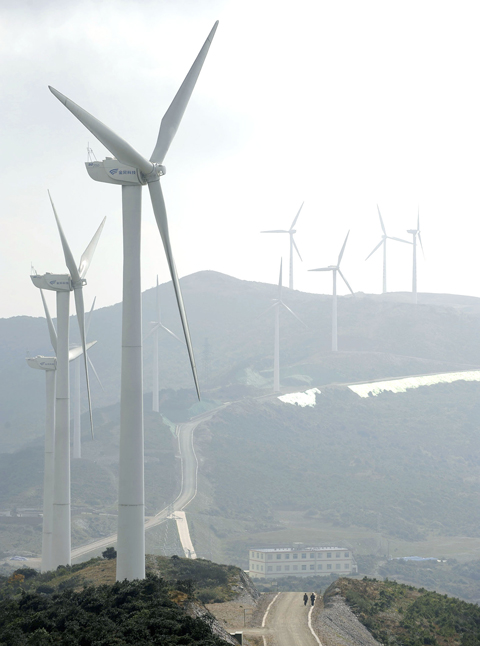
PHOTO: AFP
“But at altitude, it becomes more interesting,” he adds, gesturing at the line of 48m-high turbines.
China, which relies on coal for more than 70 percent of its energy, is the world’s largest emitter of the greenhouse gases blamed for global warming. But it has set a target of generating 15 percent of its energy from renewable sources — mainly wind and water — by 2020.
In Yunnan, the wind turbines — which operate at full tilt between October and April — are there to boost the region’s enormous hydroelectric power resources when productivity falls during the winter months.
“China is redoubling its efforts, with the 2020 target for wind power generation rising from 30 to 100 gigawatts,” Zhai said.
The rapid boom in wind farming in China — where installed capacity doubled last year for the fourth year running to sit at 12.2 gigawatts — places it behind only the US, Germany and Spain.
“In terms of the scale and the pace of the build-up of the Chinese wind industry, it’s without parallel anywhere in the world ever,” said Steve Sawyer, secretary general of the Global Wind Energy Council.
“They went from very little installed capacity and almost no industry five years ago to the point where they will be the number one market in the world this year” in terms of new capacity, he said.
“At the current rate, they will be the number one in the world in cumulative capacity by the end of 2011, early 2012,” Sawyer said.
As well as major wind farms in the north of China, such as those in Gansu Province, smaller projects — like the one in Dali — are multiplying, almost always relying on the Clean Development Mechanism (CDM).
The CDM, which was created as part of the Kyoto Protocol, allows industrialized countries to fulfill part of their greenhouse gas reduction commitments by investing in clean energy technology in developing countries.
With a generating capacity of 30.75 megawatts, the 41 turbines in Dali produce the same amount of energy as that created by burning of 20,000 tonnes of coal — thereby preventing the emission of 50,000 tonnes of carbon dioxide per year.
The carbon credits produced by the Dali pilot project, funded with a 30 million euro (US$45 million) loan from the French Development Agency, will be purchased by Dutch bank Rabobank, Zhai said.
Those credits should amount to between 7 percent and 8 percent of annual income, he said, predicting that the project should pay for itself in 10 to 15 years.
“The wind industry in China and India is one of the biggest success stories of the CDM,” Sawyer said.
“The Chinese example is a very good example: the only way you can make use of the market mechanism is if you have very clear and effective policies and measures to support the industry at the same time,” he said.
The challenge for China now, he said, was one of quality.
“They have had this rapid build-up and now they have to focus on the quality rather than just the quantity. Grid extension and connection is one issue, the performance of the turbines themselves is another,” he said.
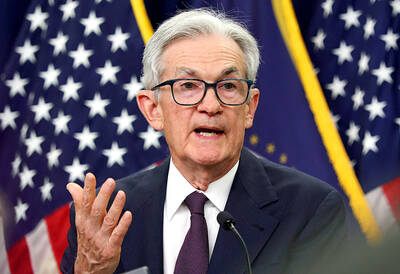
DIVIDED VIEWS: Although the Fed agreed on holding rates steady, some officials see no rate cuts for this year, while 10 policymakers foresee two or more cuts There are a lot of unknowns about the outlook for the economy and interest rates, but US Federal Reserve Chair Jerome Powell signaled at least one thing seems certain: Higher prices are coming. Fed policymakers voted unanimously to hold interest rates steady at a range of 4.25 percent to 4.50 percent for a fourth straight meeting on Wednesday, as they await clarity on whether tariffs would leave a one-time or more lasting mark on inflation. Powell said it is still unclear how much of the bill would fall on the shoulders of consumers, but he expects to learn more about tariffs
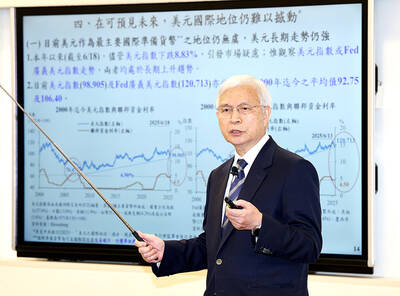
NOT JUSTIFIED: The bank’s governor said there would only be a rate cut if inflation falls below 1.5% and economic conditions deteriorate, which have not been detected The central bank yesterday kept its key interest rates unchanged for a fifth consecutive quarter, aligning with market expectations, while slightly lowering its inflation outlook amid signs of cooling price pressures. The move came after the US Federal Reserve held rates steady overnight, despite pressure from US President Donald Trump to cut borrowing costs. Central bank board members unanimously voted to maintain the discount rate at 2 percent, the secured loan rate at 2.375 percent and the overnight lending rate at 4.25 percent. “We consider the policy decision appropriate, although it suggests tightening leaning after factoring in slackening inflation and stable GDP growth,”
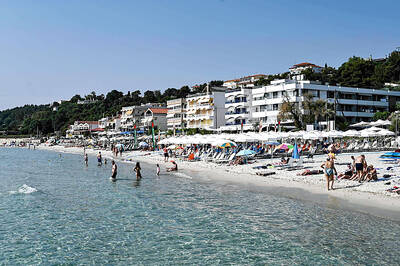
Greek tourism student Katerina quit within a month of starting work at a five-star hotel in Halkidiki, one of the country’s top destinations, because she said conditions were so dire. Beyond the bad pay, the 22-year-old said that her working and living conditions were “miserable and unacceptable.” Millions holiday in Greece every year, but its vital tourism industry is finding it harder and harder to recruit Greeks to look after them. “I was asked to work in any department of the hotel where there was a need, from service to cleaning,” said Katerina, a tourism and marketing student, who would
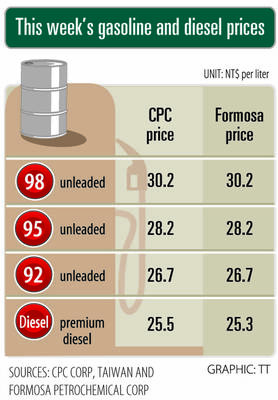
i Gasoline and diesel prices at fuel stations are this week to rise NT$0.1 per liter, as tensions in the Middle East pushed crude oil prices higher last week, CPC Corp, Taiwan (台灣中油) and Formosa Petrochemical Corp (台塑石化) said yesterday. International crude oil prices last week rose for the third consecutive week due to an escalating conflict between Israel and Iran, as the market is concerned that the situation in the Middle East might affect crude oil supply, CPC and Formosa said in separate statements. Front-month Brent crude oil futures — the international oil benchmark — rose 3.75 percent to settle at US$77.01